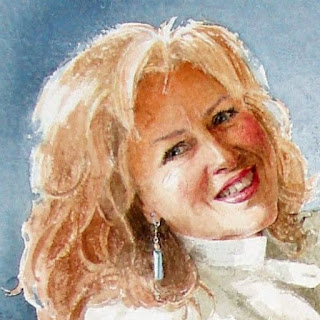
A couple of weeks ago I posted about the Aquarellistas portrait project: we started painting our own eyes and noses - with a mirror. That worked out very well and taught us how to mix skin- eye and lip colour, but not yet the proportions. We did that last time, and I realized that that is probably interesting information for everyone who paints a face from time to time, so here's the gist. If you have questions, don't hesitate to ask them via 'Comments'!
First of all - you probably all recognize this: a painting can get away with you. Usually that's a good thing, it gives your artwork your personal touch, makes it creative, special and interesting.
But for a portrait it is different. Eh, let me rephrase that - if your goal is a realistic portrait that bears resemblance to the person, it makes a difference. There are a couple of easy-to-remember rules of thumb*) that you can always use when painting a portrait:

Composition:
For the resemblance, the eyes are most important, but if the pose is 'full frontal', resemblance is more difficult to achieve it because you don't get essential information about the nose as it is flattened. Most portraits are 3/4 view, where you see the nose, and still almost all of the face. Exceptional is 'en profil', although that often gives a lot of character because it merciless shows the features
Proportions:
Very important that the eyes are in the middle of the skull. So there's as much space above the eyes (forehead and hair) as below (face). Note that also in a face there is perspective - things that are closer appear larger.
The space between the eyes is approximately the width of the nose, and an eyeball
The bottom of the nose is the middle of the face (from eyebrows to chin)
Features:
Eyes: Irises are not round (only in a surprised or frightened expression), they are flattened.
Eye-white is not really white. Only the reflections (or highlights) are white
Nose: There is always shadow under the nose, full face you hardly see the holes and the nostrils are usually soft lines. Be careful with the length of the nose especially when painting children, even a big nose is shorter that you think.
Mouth: The upper lip is darker than the lower lip (shadow on it). The mouth (incl corners) is approximately as wide as two eyes...
Important to know: like the white of an eye, teeth are never really white...
Ears: are longer that you would think - they reach at least from the middle of your eyes to the mouth
*) there are exceptions! but in general these rules work well.
Of course there is so much more - but this should get you started...



No comments:
Post a Comment
your remarks and observations to a post are most welcome! Please start typing here :)